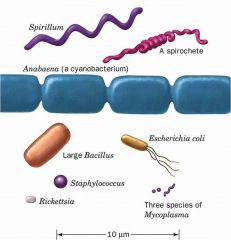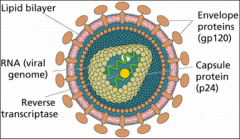![]()
![]()
![]()
Use LEFT and RIGHT arrow keys to navigate between flashcards;
Use UP and DOWN arrow keys to flip the card;
H to show hint;
A reads text to speech;
31 Cards in this Set
- Front
- Back
|
CELL IS THE FUNDAMENTAL UNIT OF
|
ALL LIVING THINGS
|
|
|
The Plasma Membrane marks
|
THE BOUNDARY OF THE CELL.
|
|
|
STATE 3 FEATURES OF THE PLASMA MEMBRANE
|
phospholipid bi-layer
Selectively permeable regulate the internal cellular composition |
|
|
IN AN AQEUOUS ENVIRONMENT WHAT DO PHOSHOPLIPDS FORM
|
MICELLES
|
|
|
WHAT ELSE CAN PHOSPHOLIPIDS FORM
STATE 2 FEATURES OF THIS |
PHOSPHOLIPIDS CAN CALSO FORM BILAYERS
WHICH HAVE HYDROPHILLIC PHOSPHATE GROUSP FACING OUTWARDS AND INWARDS AND A HYDROPHOBIC ENVIRONMENT BETWEEN THEM |
|
|
WHAT DO ALL CELLS HAVE IN COMMONG
|
they are either prokaryotes or eukaryotes
|
|
|
BACTERIA ARE WHAT TYPE OF ORGANISM
WHAT DOES THE TERM PROKARYOTE MEAN WHAT DONT PROKARYOTES CONTAIN |
Bacteria are small single-cell organisms
These are classed as prokaryotes Prokaryote means “without a nucleus” Prokaryotes generally do not contain organised membranous internal structures |
|
|
NAME ATLEAST 6 DIFFERENT PROKARYOTE TYPES
|

|
|
|
NAME 5 THINGS THAT A PROKARYOTE MAY CONTAIN
|
CAPSULE
RIBOSOME CELL WALL NUCLEOID FLAGELLA PILLI MESOOME CAPSULE ENCASING |
|
|
WHAT DO EVOLUTIONARY TREE'S INDICATE
|
Evolutionary tree indicating the lines of descent of cellular life on Earth
|
|
|
WHAT DID WE ALL DESCEND FROM ORIGINALLY
|
ANCESTRAL PROKARYOTE
|
|
|
DIFFERENCE IN eu AND PROKARYOTIC
NUCLEUS ORGANELLES GENOME HISTONES INTRONS |
prokary eukaryotic
nucleus absent nucleus present no membrane bound orgs several membran b org 1 molecule circular dna several molecules oflinear no histones histones present no introns in genes introns in genes present |
|
|
difference in eu and prokaryotic
rna polymerase ribosomes translation |
one rna polymerase type 3types
70s ribsome 80s ribosome polycistronic translation monocistronic |
|
|
In Eukaryotes the presence of a nucleus means what 3 things
|
RNA is synthesised in the nucleus
Proteins are synthesised in the cytosol Transcription has to be completed and the RNA exported from the nucleus to the cytoplasm before translation can occur |
|
|
what is the Major cell cycle difference between prokaryotes and eukaryotes
|
Continuous process in prokarotes
Discrete steps in Eukarotes Eukaryote cells need to put normal functions on hold whilst the cells divide DNA synthesis (replication) is completed before cell division can occur |
|
|
what is mitosis
|
Mitosis, the usual form of cell division in eukaryotes
leads to the production of 2 daughter cells that are genetically identical |
|
|
outline the stages of mitosis
|

|
|
|
viruses are not...
cannot..... they are obligate..... hijack.... can be a major |
Not living cells
Cannot carry out any living functions on their own Obligate intracellular parasites Hijack the cell’s machinery to get themselves replicated Can be a major cause of disease |
|
|
name 4 features of the aids hiv virus
|

|
|
|
prokaryotes also have....?
examples? |
viruses
T7 bacteriophage of Escherichia coli |
|
|
4 features of this virus
|
head containing dna
neck collar sheath tail fiber base plate |
|
|
what is KURU
|
Kuru, a neurodegenerative disease affecting the South Fore people of Papua New Guinea has been studied since the early 1900s
|
|
|
WHAT IS SCRAPIE
|
Scrapie
A neurodegenerative disease that has been found in certain flocks of sheep for centuries |
|
|
WHAT IS BSE
|
Mad Cow disease caused by feeding infected sheep carcasses to cattle
|
|
|
what is cjd
|
A Human form of BSE caused by eating BSE infected beef
|
|
|
name 4 diseases caused by prions in non humans
|
Scrapie: sheep
TME (transmissible mink encephalopathy): mink CWD (chronic wasting disease): muledeer, elk BSE (bovine spongiform encephalopathy): cows |
|
|
Humans are also susceptible to several prion diseases such as?
|
CJD: Creutzfeld-Jacob Disease
GSS: Gerstmann-Straussler-Scheinker syndrome FFI: Fatal familial Insomnia Kuru Alpers Syndrome |
|
|
when are prions usually diagnosed
what are prions resistant to there is a failure to identify a scrapie specific..... |
Usually only diagnosed fully on death of the individual affected
u.ve radiation Failure to identify a scrapie specific nucleic acid either in prion preparations or infected brains using a variety of sophisticated techniques. |
|
|
prions are also show resistance of
what isn't necessary for infectivity what are prions susceptible to |
Resistance of infectivity to agents which modify or damage nucleic acids
Nucleic acid is not necessary for infectivity Infectivity is susceptible to reagents which destroy proteins |
|
|
what are prions defined as
|
Prions are defined as "small proteinaceous infectious particles which resist inactivation by procedures that modify nucleic acids
|
|
|
what are prions often called and why
|
Prion diseases are often called spongiform encephalopathies because of the post mortem appearance of the brain with large vacuoles in the cortex and cerebellum.
|

